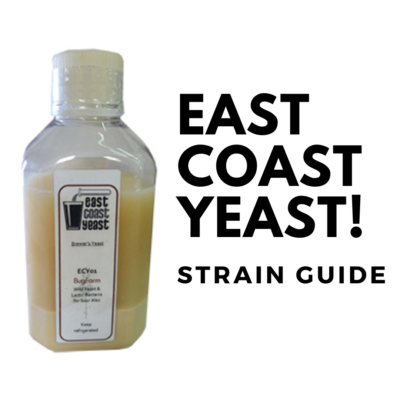
East Coast Yeast Strain Guide
East Coast Yeast’s Mission is: “To provide new, fresh, liquid cultures for your special brewing projects. Specializing in artisanal yeast blends and pure yeast strains long forgotten.”
Actually… Finding East Coast Yeast
East Coast Yeast is tough to find in stock. It’s in high demand and distribution is very limited. Fermented NJ is one of a very few sources where you can actually get ECY. Stock is usually limited and can change quickly
East Coast Yeast at fermentednj.com – see what’s available
East Coast Yeast Strain Guide!
BugFarm ECY01 – Large complex blend of cultures to emulate sour or wild beers such as lambic-style ales. Over time displays a citrus sourness and barnyard funk profile. Contains yeast (Saccharomyces, Brettanomyces) and lactic-acid producing bacteria (Lactobacillus, Pediococcus). The Brett population is > 50% of the culture. The BugFarm blend changes strains every calendar year for those who like to blend aged brews. The 2014 version contains a wild Saccharomyces yeast and four different brett isolates, L. brevis and Pediococcus.
Flemish Ale ECY02 – A unique blend of Saccharomyces, Brett, Lacto & Pedio perfect for flemish reds and sour browns. Dry, sour, leathery and notes of cherry stone. Designed for 5 gallon pitch, but may be added at any stage of fermentation.
Farmhouse Blend ECY03 – Saison brasserie blend (ECY08) with a pure Brettanomyces isolate from a small but fascinating producer of Saison. Produces a fruity and funky profile with some acidity gradually increasing over time.
Farmhouse Blend Isolate ECY03-B – This farmhouse isolate from a small but fascinating producer of Saison; Identified as Saccharomyces boulardii – a wild-type strain of Saccharomyces cerevisae. Very dry, mineral finish. Recommended Temperature: 78-82⁰F. Apparent Attenuation: up to 80%.
Brett Anomala ECY04 – Formerly known as Brettanomyces intermedius and is now named as anomala along with strains of B. clausenii and B. anomulus. This strain was first identified in beer from Adelaide, Australia. Displays a strong ester profile with some light funk and acidity.
BRETT Blend #9 ECY05 – A blend of Brettanomyces that produces a dry, leathery, horsey and/or goaty profile. Can have a pronounced barnyard character and be added at any stage of fermentation. Funk is in the house, so let it out.
Berliner Blend ECY06 – Designed to be pitched into primary fermentation for Berliner weisse, Gosebier, and other styles where lactic sourness is desired, the blend contains a kolsch ale yeast, Lactobacillus brevis and Lactobacillus delbreuckii subspecies delbreuckii.
Scottish Heavy ECY07 – CL-200 Leaves a fruity profile with woody, oak esters reminiscent of malt whiskey. Well suited for 90/shilling or heavier ales including old ales and Stouts due to level of attenuation (77-80%). Suggested fermentation temp: 60-68°F.
Saison Brasserie ECY08 – A combination of several Saison yeasts for both fruity and spicy characteristics accompanied by dryness. Apparent Attenuation: up to 80%. Suggested fermentation temp: 75-85° F.
Belgian Abbaye ECY09 – This yeast produces classic Belgian ales – robust, estery with large notes of clove and fruit. Rated highly in sensory tests described in “Brew Like A Monk” for complexity and low production of higher alcohols. Apparent attenuation 74-76%. Suggested fermentation temp: 66 – 72° F.
Old Newark Ale ECY10 – Sourced from a now defunct east coast brewery, this pure strain was identified as their “ale pitching yeast”. Good for all styles of American and English ales. Top fermenting, high flocculation with a solid sedimentation. Suggested fermentation temp: 60-68°F. Apparent Attenuation: 76-78%
Belgian White ECY11 – Isolated from the Hainaut region in Belgium this pure yeast will produce flavors reminiscent of witbiers. Suggested fermentation temp: 68-74 F. Attenuation: unknown at this time.
Old Newark Beer ECY12 – Sourced from the same defunct east coast brewery as ECY10, this pure strain was used as their “beer pitching yeast”. The strain has been identified as S. cerevisae, hence it is not a true lager strain, but should ferment at lager temperatures.
Belgian Abbaye 2 ECY13 -Traditional Abbey yeast with a complex, dry, fruity malt profile. Rated highly in sensory tests described in “Brew Like A Monk” for complexity and low production of higher alcohols. Apparent Attenuation: 74-76%. Suggested fermentation temp: 66-72° F.
Saison ECY14 – This pure strain leaves a smooth, full character with mild esters reminiscent of apple pie spice. Apparent attenuation 76-78%. Suggested fermentation temp: 75 – 82° F.
Munich Festbier ECY15 – From one of the oldest breweries in Munich, this pure strain is recommended for many German lagers such as Helles, Dunkel, and Oktoberfest. Suggested fermentation 46-54°F. Medium attenuation.
Burton Union ECY17 – Produces a bold, citrusy character which accentuates mineral and hop flavors. Well-suited for classic British pale ales and ESB.
British Mild ECY18 – This yeast has a complex, woody ester profile and is typically under-attenuating (does not ferment maltotriose) leaving a malt profile with a slight sweetness that is perfect for milds, bitters, or “session ales”.
Recommended fermentation temp: 60-68°F.
Attenuation: 66-70%.
BugCounty ECY20 – A mixed culture of wild yeast and lactic bacteria to emulate sour or wild beers such as lambic-style ales. Over time displays a citrus sourness and barnyard funk profile. Contains yeast (Saccharomyces, Brettanomyces) and lactic bacteria (Lactobacillus, Pediococcus). The Brett population is typically >50% of the culture pitch. The blend of strains change every calendar year for those who like to blend or have solera projects. The 2014 version contains a wild Saccharomyces yeast, four brett strains, various lactobacilli and Pediococcus.
Kölschbier ECY21 – CL-450. Produces a clean lager-like profile at ale temperatures. Smooth mineral and malt characters come through with a clean, lightly yeasty flavor and aroma in the finish. Recommended fermentation temperature: 58-66ºF; Apparent attenuation: 75-78%.
Oud Brun ECY23 – A unique blend of Belgian Saccharomyces yeast and Lactobacilli species (L. delbrueckii, L. mali for the bulk production of lactic acid, and L. brevis for lactic & slight acetic acid). For those who prefer sourness without the presence of Brett.
East Coast Session Ale ECY27 – Soft, yeasty, fruity nose with complex esters of ripe fruit, apricots, and rose petals. Unique for Bitters, Scottish Shilling Ales, and session IPAs.
Kellerbier ECY28 – This yeast CL-660 exhibits a clean, crisp lager in traditional northern German character. Use in German Pilsners including Kellerbier. Recommended fermentation temperature 46-54ºF; Apparent attenuation: 74-76%
North East Ale ECY29 – Replication of the famous Conan strand of yeast. Unique strand with an abundance of citrsy esters accentuating American Style hops in and IPA, Double IPA, or strong ale.
Brett Naardenensis ECY30 – An intriguing species of Brett that may create acetic acid with a mousy-tainted flavor, but after fermentation and aging (approximately 6 months) intense esters of strawberry, honey, ripe fruit with a tart, citrus acidity. The isolate was first found as a soft drink contaminant.
Senne Valley Blend ECY31 – “Intended for primary fermentations due to the portfolio of wild oxidative yeasts. Emulating ales by employing similar microflora recently observed from a prominent Lambic producer, this new blend includes various unique yeasts (Debaryomyces, Priceomyces , Wickerhamomyces, and Pichia). Contributes to aroma through the production of volatile compounds and higher terpenol flavors. Rounding out the blend : Lactic bacteria, Wild-type Saccharomyces from the Senne Valley, and multiple strains of Brettanomyces bruxellensis. Extremely wild with notes of smokey barnyard, musty funk, and ethyl acetate. We recommend aging a minimum of one (1) year.”
Lactobacillus Brevis ECY32 – “This strain of Lactobacillus Brevis was originally isolated from Kefir. Bright acidity and hop-tolerant (up to 30 IBU).
Fermentation temperature 60 – 80 F.”
Dirty Dozen Brett Blend ECY34 – Twelve (12) different isolates of Brettanomyces exhibiting high production of barnyard “funk” and esters. Dryness, ripe fruit, and acidity will be encountered over a period of months and over time (>1 yr), may display gueuze-like qualities in complexity. Contains various isolates from lambic-producers, B. bruxellensis, B. anomala, B. lambicus, and B. naardenensis. For those who want the most from Brett yeast, whether a 100% Brett fermentation is desired or adding to secondary aging projects.
Brettanomyces Bruxellensis ECY35 – “Name of Alternate state or synonym: Dekkera intermedia. Isolated from Belgian Gueuze, this yeast will be quite funky with barnyard notes accompanied by ripe tropical fruit.”
Dour Saison ECY41 – Dry, peppery, and complex earthy notes. Saccharomyces cerevisiae var. diastaticus. Fermentation Temp 77-80°F. Attenuation: 77-83%.
Nordic Farmhouse ECY43 – Sigmund strain of Kveik yeast (Saccharomyces cerevisiae). Traditionally used in the production of Norwegian Farmhouse Ale yielding spicy orange peel flavor, particularly if underpitched. Recommended Fermentation temperature: 90-105 ºF. Pitch temperature: 102ºF . Apparent Attenuation: 78 – 83%.
Farmhouse 2 ECY46 – An American farmhouse isolate (Saccharomyces cerevisae / boulardii) producing a pleasant tartness quickly upon fermentation (pH 4.0 – 4.1). Expect high attenuation, Slight citrus esters and tartness. Suggested fermentation temperature: 76-82⁰F. Apparent Attenuation: 80-84%.
Available Strains
Being a small yeast house affords ECY the luxury of providing homebrewers with a variety of yeast. Beyond the general availability issues that have already been mentioned ECY changes strains, this guide is a reference that lists all strains that we’ve become aware of. That to say, not all strains are produced.
See What’s Currently Available:
East Coast Yeast is tough to find in stock. It’s in high demand and distribution is very limited. Fermented NJ is one of a very few sources where you can actually get ECY. Stock is usually limited and can change quickly
East Coast Yeast at fermentednj.com
More Strain Guides & Related!
- Omega Yeast Labs Homebrew Strain Guide
- Imperial Yeast Homebrew Strain Guide
- Finding the “Conan Strain” of Yeast – Vermont IPA
- Finding Harder To Find Yeast Strains
More Homebrew Finds!
- Last 50 Finds!
- Top Deals – a curated list of the best deals
- Homebrew Reviews – one of the largest libraries of homebrew reviews in existence!
- Our Top Posts – tips, how-tos, resources posts and more
- Let’s be Friends!
Recent Deals!
10 Most Recent Homebrew Resource Posts & How-To’s!
We are Homebrew Review HQ! Our 10 Most Recent Reviews
More Fermentation Related!
- Our Fermentation Related Reviews – Fermenters and More
- Yeast Starters and Fermentation Resource Page
- Yeast: The Practical Guide to Beer Fermentation
- Compare Prices: StirStarter Stir Plate
This post may contain affiliate links. We may make a commission when you use our links. This will never cost you extra. Thank you for supporting Homebrew Finds!
Price, promotions and availability can change quickly. Check the product page for current price, description and availability. toppost:ECY tag:tpr




